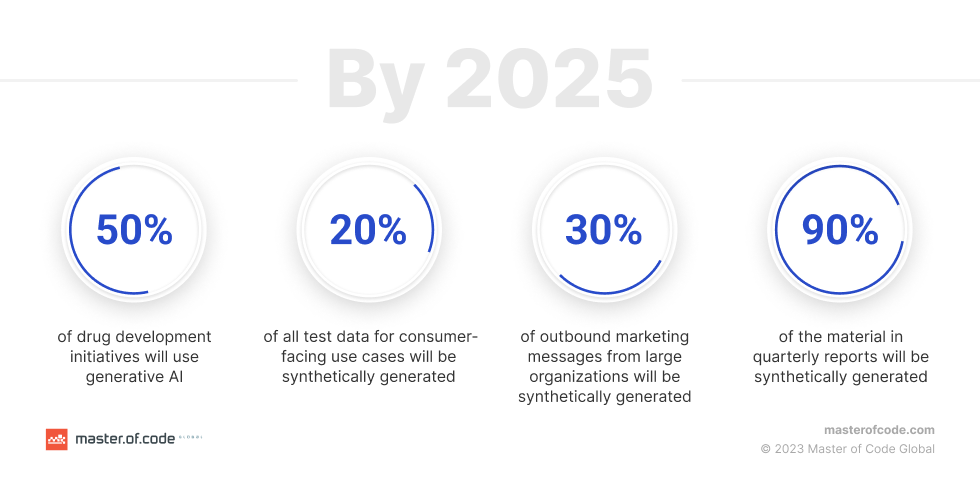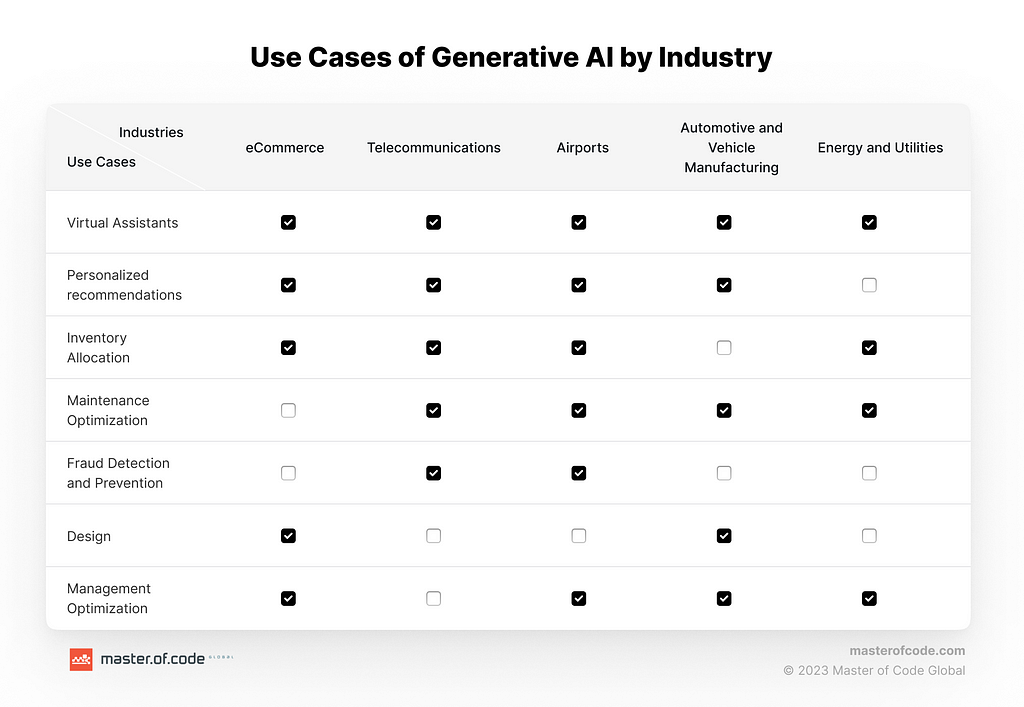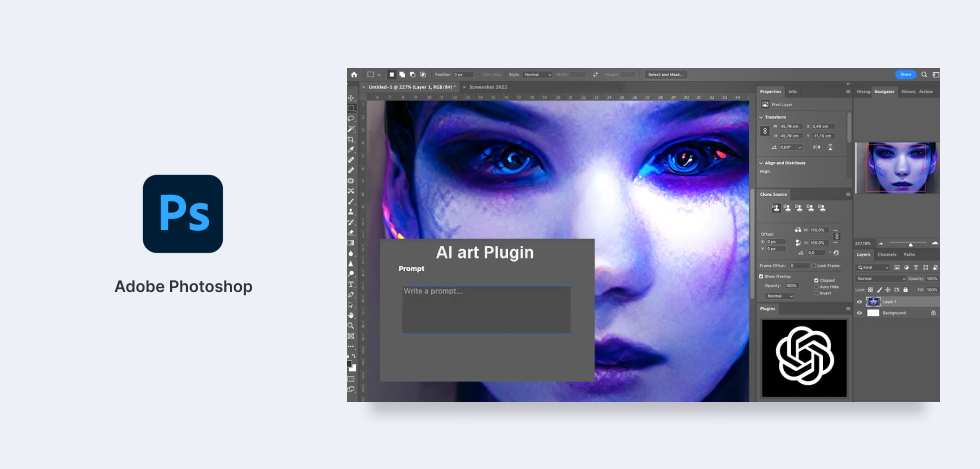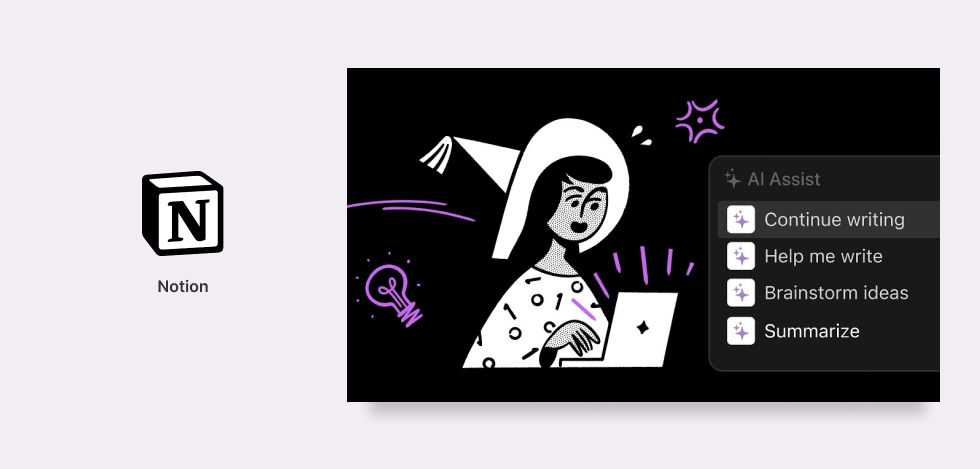Your cart is currently empty!
Generative AI for Enterprises: Statistics, Use Cases, Top Examples
Unlocking the Potential Of Generative AI for Enterprises: Statistics, Use Cases, Top Business Examples

In 2022, Generative AI (Artificial Intelligence) has become a hot topic, with social media platforms showcasing images created by generative machine learning models like DALL-E and Stable Diffusion. This technology stands behind ChatGPT, a chatbot developed by Open AI, and attracted even more attention to Generative AI. Basically, Generative AI is a branch of AI that generates various types of data, such as audio, images, text, code, and more, using existing data as inspiration and creating new outputs.
Generative AI is creating a lot of excitement due to its versatility in creating content, art, music, and augmenting data. ChatGPT has gained a massive user base, reaching 100 million monthly active users in just two months after its launch, and investment in this field is growing rapidly. The potential impact of this technology is significant, with Google expressing concern about its effect on search revenue. The competition is heating up, with Google announcing Bard, their conversational AI service, and Microsoft updating Bing with these technologies.

Potential Benefits of Generative AI Adoption for Enterprises
- Increased productivity. Generative AI can automate repetitive tasks, such as image or video editing, freeing up employees to focus on more strategic work. By 2027, approximately 30% of manufacturers will have adopted generative AI technology to enhance the efficiency of their product development processes (Gartner).
- Personalized customer experience. Generative AI can be used to personalize content for customers, such as personalized product recommendations, leading to improved customer engagement and increased sales. According to a survey of professionals in the United States conducted in 2023, 37% of those working in advertising or marketing reported using artificial intelligence (AI) to aid in their work tasks (Statista).
- Boosted creativity. Generative AI enhances creativity by providing new tools and techniques for artists, designers, and writers to explore and experiment with.
- Reduced costs. Generative AI reduces costs by automating tasks and streamlining workflows, leading to increased productivity and lower overhead. According to McKinsey, generative design could save 23–38% of engineering time, resulting in cost reductions of 8–15% while producing creative and non-intuitive solutions.

Find out the return on investing in AI for customer service: Calculate ROI
- Improved customer experience. Generative AI helps enterprises create personalized content and experiences that resonate with customers, leading to increased loyalty and satisfaction.
- Boosted scalability. Generative AI scales content production to meet demand, enabling enterprises to produce large volumes of high-quality content quickly and cost-effectively.
- Higher competitive advantage. Generative AI provides a competitive advantage by enabling enterprises to create unique and original content that sets them apart from their competitors.
Generative AI Use Cases for Enterprises by Industry
Generative AI in enterprises is used for tasks such as creating personalized product recommendations, generating natural language responses for customer service, automating content creation, predicting customer behavior, and enhancing data analysis. According to Gartner, by 2025, Generative AI will account for 10% of all data produced, up from less than 1% today.

Generative AI Use Cases for the eCommerce Industry
Generative AI has a lot of potential use cases for the eCommerce industry. Generative AI chatbots for eCommerce provide personalized customer support and product recommendations. Generative AI also optimizes inventory management by predicting demand and adjusting stock levels accordingly. Another use case is Generative Design, which helps product designers and engineers to optimize designs and find innovative solutions. Overall, Generative AI has the potential to automate various tasks, improve efficiency, and provide a competitive edge for eCommerce businesses in a crowded market.
Generative AI Use Cases for the Telecommunication industry
In 2021, the size of the global AI in telecommunications market was $1.2 billion, and it is anticipated to grow to $38.8 billion by 2031, with a compound annual growth rate (CAGR) of 41.4% from 2022 to 2031. Generative AI has the potential to empower the telecommunications industry through various use cases. Telecom virtual assistants can assist customers with inquiries, billing, and account management, providing a personalized experience. By analyzing data on usage patterns, device type, and location, Generative AI generates personalized recommendations based on customer behavior. Inventory allocation can be optimized by predicting demand and adjusting stock levels accordingly using Generative AI. Equipment failure prediction and maintenance schedules can also be automated within the Generative AI model. Additionally, fraud detection and prevention can be improved by using Generative AI to analyze patterns and flag suspicious behavior.
Generative AI Use Cases for Airports
Generative AI-powered airport chatbot assists travelers with flight information, directions, and other queries. Using Generative AI, airports can analyze passenger data, such as flight history and preferred amenities, to recommend personalized services, such as dining options or retail offerings. Predicting demand and adjusting stock levels accordingly helps ensure the availability of essential products and services for passengers.
Generative AI can help airports schedule and prioritize maintenance tasks for their facilities and equipment based on data such as usage patterns and historical performance. Overall, Generative AI has the potential to transform the airport industry by providing smarter, more personalized services for travelers and improving operational efficiency.
Generative AI Use Cases for Automotive and Vehicle Manufacturing
Generative AI is increasingly being adopted by enterprises in the automotive and vehicle manufacturing industry. The market size for AI in manufacturing is currently estimated to be worth USD 2.3 billion in 2022. It is projected to grow at a compound annual growth rate (CAGR) of 47.9% from 2022 to 2027, reaching a market size of USD 16.3 billion by 2027.
Generative AI helps to develop virtual assistants that interact with customers and provide them with personalized recommendations for cars, services, and maintenance. Management Optimization is achieved by analyzing large amounts of data from various sources for production planning, quality control, and supply chain management. Prediction maintenance issues before they occur reduces downtime, improve vehicle performance, and increases safety.
Generative AI Use Cases for Energy and Utilities Industry
Generative AI has the potential to transform the Energy and Utilities industry. Some of its use cases include creating virtual assistants for customer service, analyzing customer data for personalized recommendations, optimizing inventory allocation, predicting equipment failures for maintenance optimization, detecting fraudulent activities, and optimizing management tasks. These applications can help improve efficiency, reduce waste, prevent losses, and enhance profitability in the industry.
AI can be utilized to monitor carbon emissions, and it has significant potential for multinational companies’ sustainability plans. According to Boston Consulting Group, AI implementation could yield additional revenues and cost savings worth $1.3tn to $2.6tn by 2030. The UK government also launched a £1.5m program in late 2022 to explore the use of AI in reducing carbon emissions.
Top examples of businesses that have adopted Generative AI technology
Generative AI technology has already made a significant impact in various fields, and its adoption is expected to increase in the coming years. Here, we highlight some top examples of businesses that have embraced Generative AI technology and are reaping its benefits.
Generative AI business example: Adobe Photoshop
Adobe announced at its 2022 Max conference the addition of Generative AI capabilities as beta options in its Creative Cloud suite, including Photoshop, Lightroom, and Premiere Pro. The company showcased 10 AI projects during the conference, such as Project Clever Composites, which simplifies the tedious process of compositing images into backgrounds. Other projects include Project Instant Add, which uses AI to map graphics to video elements, and Project Vector Edge, which provides designers with the ability to collaborate on 2D designs in 3D environments. These projects aim to improve the creative process by automating complex and time-consuming tasks.

Generative AI in Photoshop creative tools allow users to add new objects to an image, create variations based on their existing image, or even add a new section to their composite just by describing what they want.
Generative AI business example: Notion
Notion has launched an Alpha of Generative AI Copywriting Tool that can assist users in generating outlines for blogs, social media posts, and other content pieces. Notion AI can also produce drafts for various types of documents, such as meeting agendas, press releases, brainstorms, and even poems, upon request. On top of that, it could work with your text to fix spelling & grammar, summarize the idea of the text, or translate it.

According to Forbes, after the announcement of the release of Notion AI, there were well over 50,000 users on the waitlist.
Generative AI business example: BMW
BMW used Generative AI technology to create a unique piece of art called “The Ultimate AI Masterpiece” to project it onto its 8 Series Gran Coupe line. The project involved training an AI algorithm with 50,000 images of artwork spanning 900 years of history to create a new, one-of-a-kind design.

Generative AI business example: Autodesk
Autodesk is highly focused on AI-based generative design, in which designers or engineers input design goals into the generative design software, along with parameters such as performance or spatial requirements, materials, manufacturing methods, and cost constraints. The software explores all the possible permutations of a solution, quickly generating design alternatives. It tests and learns from each iteration what works and what doesn’t.
Generative AI business example: Snapchat
Snapchat has launched a chatbot called “My AI,” which utilizes OpenAI’s text engine, ChatGPT? While My AI cannot generate lengthy essays, it can perform tasks that Snapchat users typically enjoy, including providing travel recommendations, suggesting gift ideas, composing poems, and proposing recipes.

My AI was created as a companion for Snapchat users to engage with when no human contact is available. My AI is a version of Snapchat’s ChatGPT, tailored for mobile devices, and is currently limited in functionality.
Generative AI business example: Salesforce
Salesforce announces Einstein GPT — Generative AI for CRM. Einstein GPT for Sales enables the auto-generation of sales tasks, such as scheduling meetings and composing emails, while Einstein GPT for Service generates personalized agent chat replies and knowledge articles from past case notes. Einstein GPT for Marketing can dynamically create personalized content to engage customers, while Einstein GPT for Developers can generate code and provide assistance in programming languages like Apex. Finally, Einstein GPT for Slack Customer 360 apps delivers AI-powered customer insights in Slack, such as smart summaries of sales opportunities and surfacing end-users’ actions like updating knowledge articles.

Also, Salesforce Ventures, the investment branch of the company, introduced a new fund worth $250 million that focuses on generative artificial intelligence. This fund aims to support the startup community and promote the growth of responsible generative AI.
Wrapping up…
In the past, several businesses, including those in eCommerce and other industries, have shown reluctance to adopt artificial intelligence. However, as market conditions and consumer trends evolve, it has become clear that generative AI will play a critical role in shaping the future of enterprises. The advantages of utilizing AI are substantial and cannot be ignored any longer, especially since the cost of implementing such solutions has become increasingly affordable.
Our team of AI experts can integrate Generative AI into an existing Conversational AI platform. We provide the opportunity to upgrade practically any existing bot project to the level of Natural language generation technology — whether it is customer support, retail sales, information services, consulting, or processing systems query.
Submit a request for a Proof of Concept (POC): Explore the advantages of Generative AI in your company. POC will be done in 2 weeks to validate the business idea!

Generative AI for Enterprises: Statistics, Use Cases, Top Examples was originally published in Chatbots Life on Medium, where people are continuing the conversation by highlighting and responding to this story.